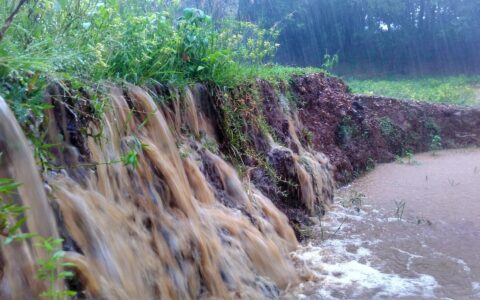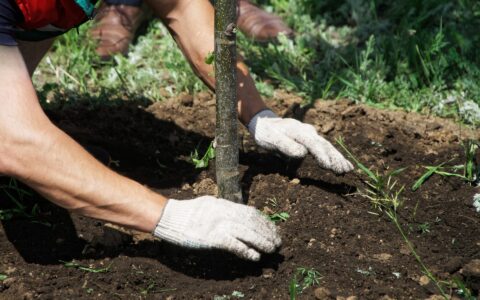Imagine stepping out your back door and being greeted with a world of color. Towering palm trees sway gently in the breeze while blooming bushes burst with vibrant flowers. All these South Florida plants add a touch of magic to your landscape.
This isn’t just a dream – it’s your own piece of paradise! However, achieving a thriving landscape this close to the ocean requires choosing the right plants. So, let’s explore all sorts of options, from eye-catching flowering bushes to low-maintenance ground covers. With so many choices, you’re sure to find plants that match your style and needs.
Key Takeaways
- South Florida’s unique climate allows for a vibrant year-round landscape but it’s one that presents unique challenges for plants.
- Sun exposure, water needs, and salt tolerance are all things you should take into consideration when selecting plants for your landscape.
- Plant a variety of low-maintenance native plants to save time, money, and water.
- For a thriving landscape, you don’t have to worry about, consider professional help.
Important Considerations for Choosing South Florida Plants
With sunshine and warm temperatures, it’s hard not to fall in love with living in South Florida. However, our climate presents some unique challenges for plants. From the scorching sun and afternoon storms to the ever-present humidity and coastal salt spray, not all plants will thrive here.
To ensure your plants flourish and help create the beautiful yard you desire, consider these three key factors:
1. Sun Exposure
South Florida sunshine can be intense, and the amount of light a plant receives significantly impacts its growth and flowering. There are three main types of sunlight needs in plants:
- Full Sun: These plants thrive in at least 6 hours of direct sunlight daily. South-facing yards and open areas are ideal for these heat-tolerant plants.
- Partial Shade: Plants that thrive in partial shade prefer dappled sunlight for 3-6 hours a day. These plants are perfect for east—or west–facing areas with some afternoon shade from trees or structures.
- Full Shade: North-facing areas or spots under the canopy of taller trees often receive less than 3 hours of direct sunlight.
2. Water Needs
We experience frequent rain, but our sandy soil often drains quickly. Understanding a plant’s water requirements is important to avoid underwatering or overwatering, both of which can lead to stress and stunted growth. Plants fall under one of the following water requirement categories:
- Drought-Tolerant: Once established, these low-maintenance plants thrive with minimal watering. They are perfect for busy lifestyles, water conservation efforts, or those who have second homes in Florida and don’t want to worry about their plants while they are away.
- Moderate Water Needs: Most Florida-friendly plants fall into this category, requiring regular watering during dry spells while also tolerating periods when we don’t receive any rain.
- High Water Needs: If you have a water garden, boggy area, or enjoy a lush, constantly hydrated landscape, there are even certain aquatic plants that can thrive in ponds and water features.
Fresh water is a precious resource we are all trying hard to protect, it’s also important to find Florida-friendly landscaping to save time, money, water, and our environment. For the best native plants, visit your local nursery.
3. Salt Tolerance
Living near the coast brings a unique challenge: salt spray. This invisible mist that is carried by ocean winds can wreak havoc on some plants and cause leaf burn and stunted growth.
Choosing salt-tolerant plant varieties ensures your landscape thrives when you’re so close to the beach.
Top Plant Choices for Your South Florida Landscape
Ready to transform your landscape into the yard you’ve always dreamed of? Now that you understand how South Florida’s sunshine, water, and salty air affect plant health, it’s time to start picking the right plant for the right place.
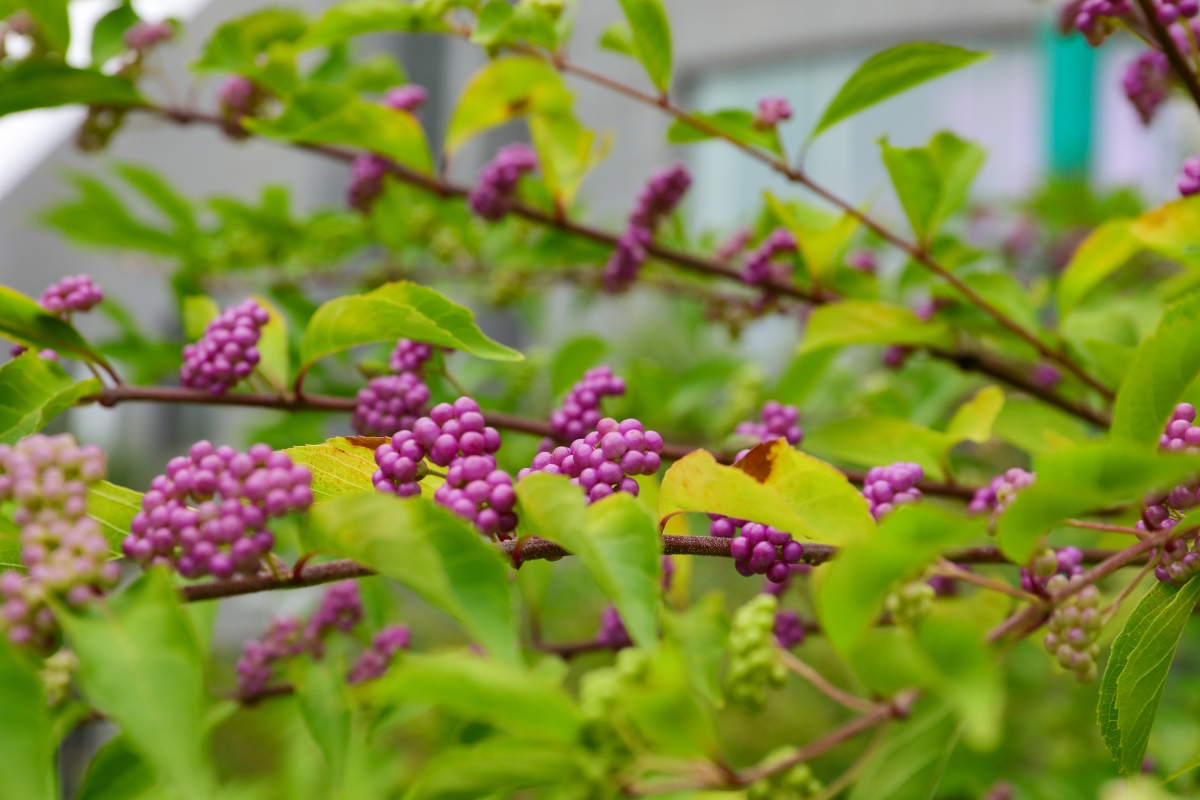
The beautyberry shrub (Callicarpa americana) offers stunning purple berries.
Flowering Shrubs
Watch your landscape come alive with flowering shrubs! Not only do they explode in a variety of colors throughout the year, but these butterfly and hummingbird magnets create a haven for pollinators. Plus, they can double as privacy screens for your front porch or against your fence line, adding beauty and functionality.
- Bay Cedar (Suriana maritima): A coastal shrub with small, yellow flowers and tough, evergreen foliage, ideal for stabilizing sand dunes.
- Beautyberry (Callicarpa americana): A deciduous shrub with striking clusters of bright purple berries and small, lavender flowers.
- Coral bean (Erythrina herbacea): A shrub with striking red tubular flowers and distinctive, spiny stems, often used in butterfly gardens. Warning: Parts of this plant are toxic, particularly to dogs.
- Firebush (Hamelia patens): A fast-growing, tropical shrub with tubular red flowers and dark green foliage, attracting hummingbirds and butterflies.
- Inkberry (Scaevola plumieri): A sprawling, salt-tolerant shrub with small, white flowers and black berries, commonly found in coastal areas.
- Jamaican caper (Capparis cyanophallophora): An evergreen shrub with fragrant white flowers that turn pink, known for its ornamental and medicinal uses.
- Marlberry (Ardisia escallonioides): A small tree or large shrub with glossy leaves and clusters of white flowers followed by black berries.
- Swamp mallow (Hibiscus coccineus): A tall perennial with large, scarlet flowers and deeply lobed leaves, thriving in wet, sunny areas.
- Walter’s viburnum (Viburnum obovatum): A versatile, evergreen shrub with small, white flowers and dark green foliage, used in hedges and wildlife gardens.
- White indigo berry (Randia aculeata): A thorny shrub with fragrant white flowers and small, white berries, often used in native landscaping.
- Wild coffee (Psychotria nervosa): A shade-loving shrub with glossy leaves, white flowers, and red berries, popular in native and butterfly gardens.
- Wild olive (Osmanthus americanus): A small tree or large shrub with fragrant white flowers and dark green, leathery leaves, used in ornamental landscaping.
- Yellow anise (Illicium parviflorum): An evergreen shrub with aromatic leaves and small, yellow-green flowers, often used as a hedge or screen.
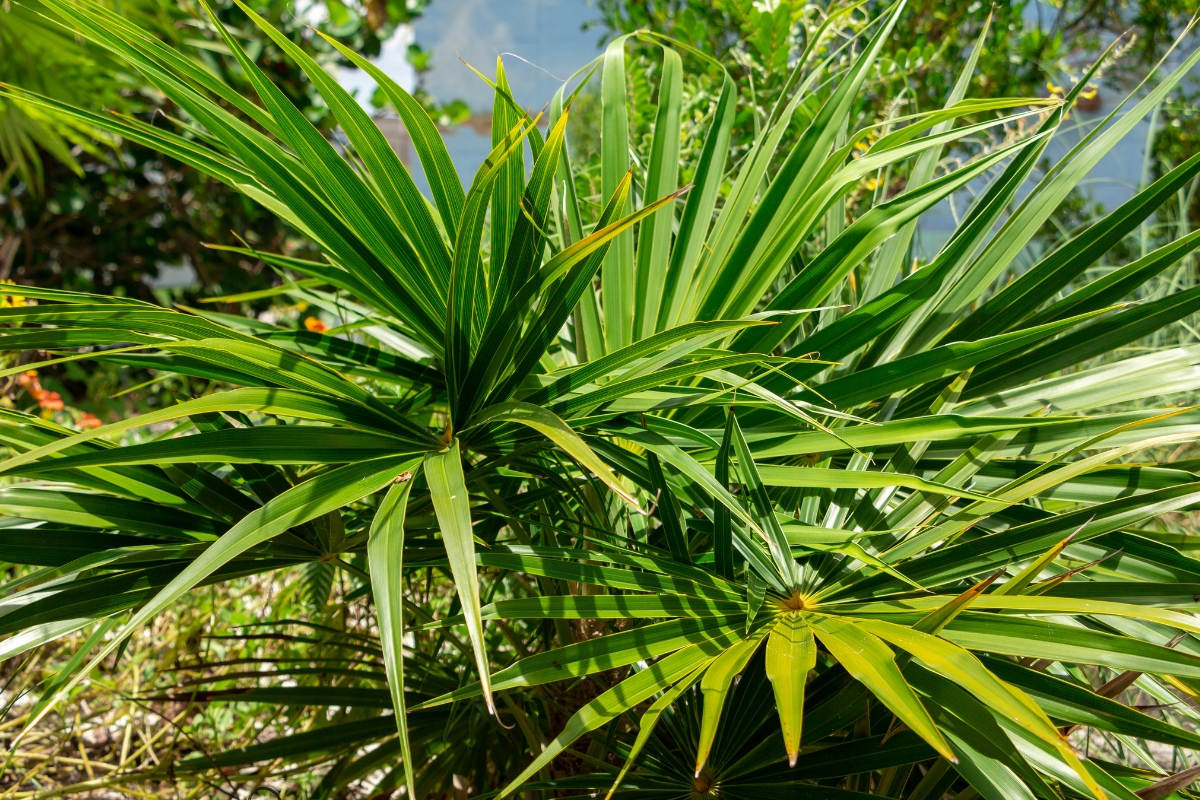
This Florida thatch palm is a low-maintenance plant that adds a touch of elegance to your landscape.
Palms & Cycads
Surprise! You might be wondering what palms are doing on a list of plants. Technically, palms are classified as monocots, meaning they’re more closely related to grasses and lilies than oak and maple trees, which are dicots. Despite the botanical twist, planting palms in your yard is undeniably a staple here in South Florida. Get ready to elevate your tropical paradise with any of these towering palms or prehistoric cycads!
- Buccaneer palm (Pseudophoenix sargentii): A slow-growing, ornamental palm with a smooth trunk and feathery fronds, suited to coastal environments.
- Cabbage palm (Sabal palmetto): A hardy, salt-tolerant palm with a fan-shaped frond, commonly used in landscaping and as a state symbol of Florida.
- Dwarf palmetto (Sabal minor): A small, hardy palm with blue-green, fan-shaped leaves, often found in swampy or shady areas.
- Florida thatch palm (Thrinax radiata): A slender, elegant palm with fan-shaped leaves and a smooth trunk, ideal for tropical landscapes.
- Florida royal palm (Roystonea elata): A majestic, tall palm with a smooth, gray trunk and feathery fronds, often used as a focal point in tropical gardens.
- Needle palm (Rhapidophyllum hystrix): A small, hardy palm with needle-like spines and fan-shaped leaves, known for its cold tolerance.
- Paurotis/Everglades palm (Acoelorrhaphe wrightii): A clumping palm with slender trunks and feathery fronds, commonly found in wetlands and coastal areas.
- Queen sago (Cycas circinalis): An ancient, slow-growing cycad with a crown of stiff, feather-like leaves, often used as a dramatic landscape accent.
- Saw palmetto (Serenoa repens): A hardy, low-growing palm with fan-shaped leaves and sharp, saw-toothed stems, known for its medicinal properties.
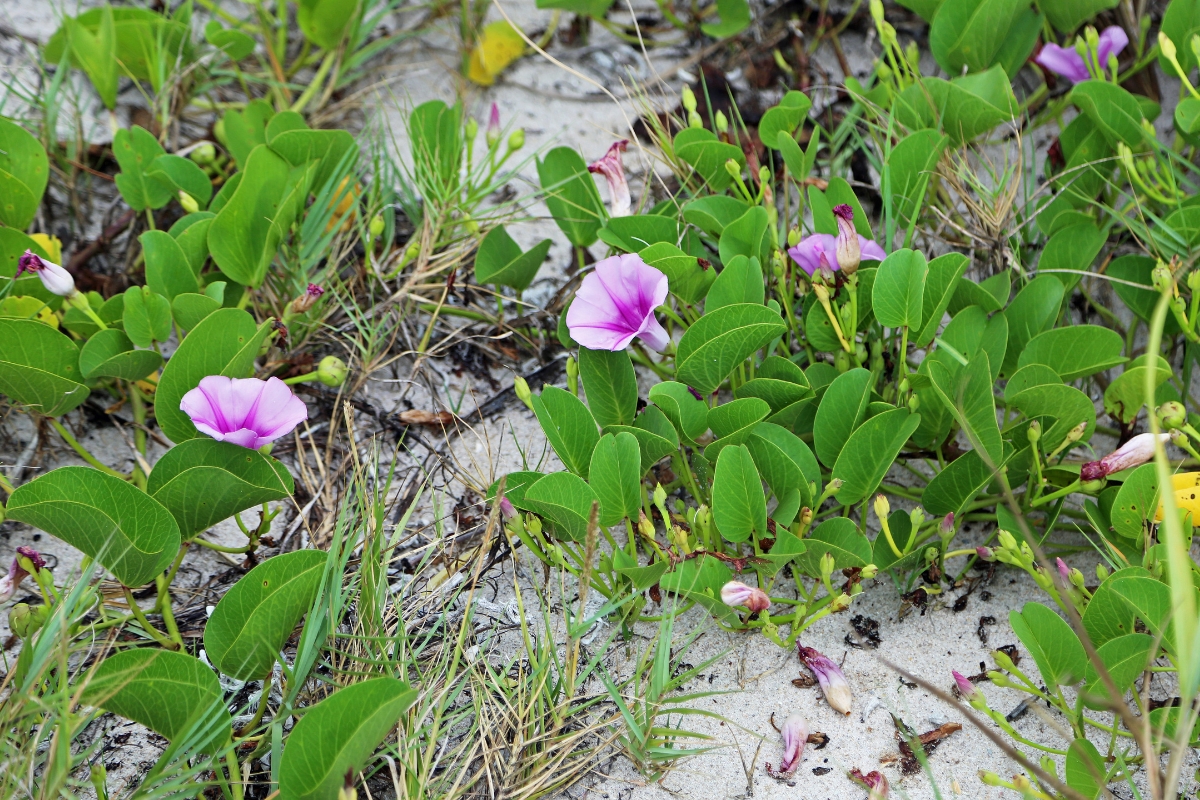
The railroad vine (Ipomoea pes-caprae) adds a touch of vibrant green and delicate purple flowers to this South Florida backyard. This fast-growing vine is a great option for softening common eyesores, like sheds and utility boxes, on your property.
Groundcovers & Vines
These versatile plants help fill bare spots, suppress weeds, and add beautiful texture and color throughout the seasons. With the way vines can climb fences, trellises, or even cascade over walls, they make a fun and whimsical addition to your vertical gardens.
- Blue Jacquemontia (Jacquemontia pentanthos): A twining vine with delicate blue flowers, known for its rapid growth and ability to attract pollinators.
- Bougainvillea (Bouganvillea spectablilis): A vibrant, thorny vine renowned for its colorful bracts and hardy nature in tropical climates.
- Coral honeysuckle (Lonicera sempervirens): A perennial vine with tubular red flowers that attract hummingbirds and butterflies.
- Corky-stemmed passionflower (Passiflora suberosa): A climbing vine with unique, small flowers and corky-textured stems, producing small, edible fruits.
- Crossvine (Bignonia capreolata): A semi-evergreen climber with trumpet-shaped, orange-red flowers that bloom profusely in spring.
- Passionflower (Passiflora incarnata): An exotic-looking vine with intricate purple and white flowers, known for its edible fruit and medicinal properties.
- Mondo grass (Ophiopogon japonicus): A low-growing, grass-like perennial often used as ground cover, with dark green, strappy leaves.
- Purple love grass (Eragrostis spectabilis): An ornamental grass with delicate, purple-hued seed heads that create a hazy, colorful effect in late summer and fall.
- Railroad vine (Ipomoea pes-caprae): A sprawling, beach-dwelling native vine with large, purple-pink flowers and thick, fleshy leaves, known for stabilizing sand dunes.
- Trailing Lantana (Lantana montevidensis): A low-growing, spreading plant with clusters of lavender or purple flowers, valued for its tolerance of coastal conditions and its long blooming period.
- Trumpet vine (Campsis radicans): A vigorous climber with large, trumpet-shaped orange flowers that attract hummingbirds and provide summer interest.
- Yellow Jessamine (Gelsemium sempervirens): A twining vine with fragrant, bright yellow flowers that bloom in late winter to early spring, often used for covering fences and trellises.
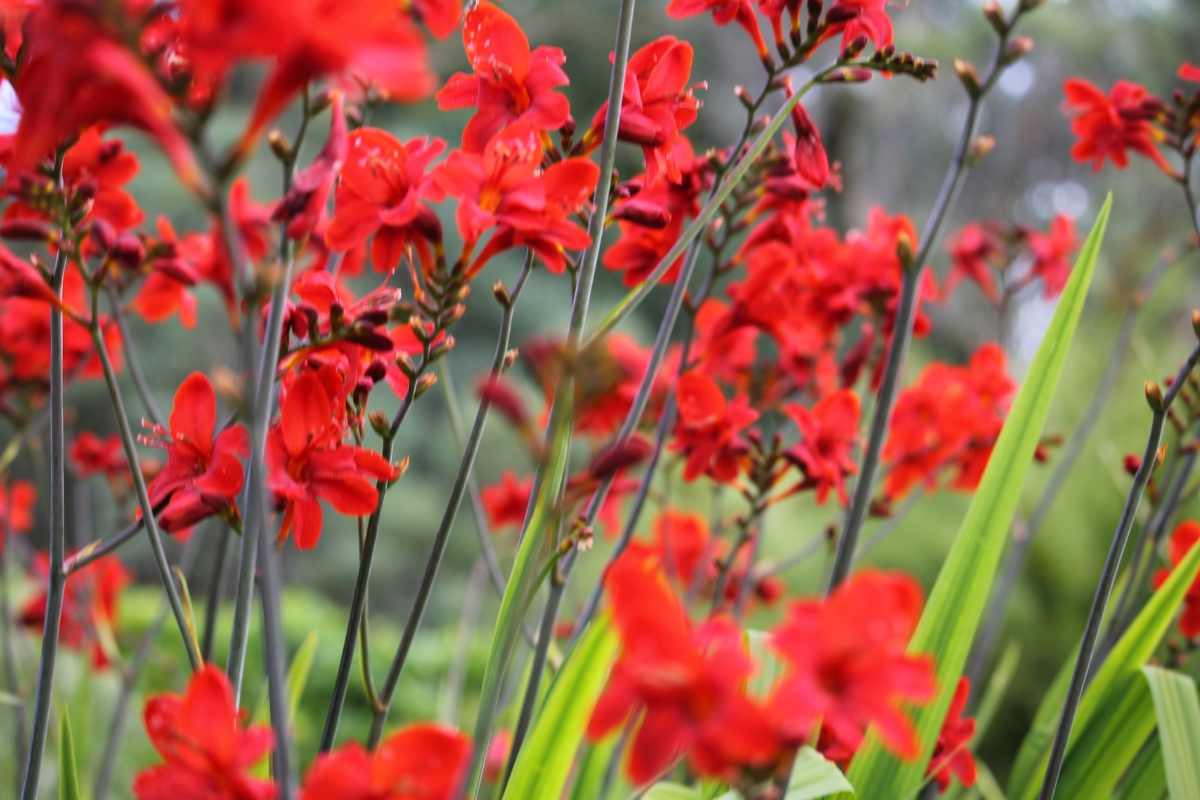
The cardinal flower (Lobelia cardinalis) adds a pop of color to your landscape. Its vibrant red blooms help attract pollinators like butterflies, bees, and hummingbirds to your South Florida property.
Perennials
Perennials offer nonstop color in your landscape design, and the best part? They come back year after year! Here are a few local favorites:
- Beach sunflower (Helianthus debilis): A hardy coastal plant with bright yellow flowers and a spreading habit, ideal for erosion control and attracting pollinators.
- Cardinal flower (Lobelia cardinalis): A striking perennial with vibrant red, tubular flowers that attract hummingbirds and thrive in moist, shady areas.
- Green eyes (Berlandiera subacaulis): A low-growing, drought-tolerant perennial with yellow daisy-like flowers and a unique green center.
- Purple coneflower (Echinacea purpurea): A popular, hardy perennial with large, purple-pink flowers and a prominent cone-shaped center, known for its medicinal uses.
- Shrub verbena (Lantana depressa): A low-growing, spreading shrub with clusters of yellow flowers, valued for its resilience and ability to attract butterflies.
- Sea oxeye daisy (Borrichia frutescens): A salt-tolerant perennial with bright yellow daisy-like flowers, commonly found in coastal and marshy areas.
- Stokes Aster (Stokesia laevis): A perennial with large, showy blue or lavender flowers, often used in borders and rock gardens.
- Tickseed (Coreopsis leavenworthii): A native wildflower with bright yellow, daisy-like flowers, known for its long blooming season and use in wildflower meadows.
- Virginia Iris (Iris virginica): A water-loving perennial with striking blue or purple flowers, often found in wetland areas.
Get Expert Tips and Support for Your South Florida Landscape from Sherlock Tree Company
From understanding our unique climate to choosing the perfect plants for each area of your yard, you’re well on your way to transforming your outdoor space into the little piece of paradise you’ve always desired.
At Sherlock Tree Company, we’re passionate about helping your trees, shrubs, and plants thrive. From spring blooms to protecting your landscape from winter’s cold
embrace, we are here for year-round support. Our team of experts can provide personalized advice based on your specific needs.
Call Sherlock Tree Company today at 954-788-4000 or request an estimate on our website.
Call Sherlock for quality tree services
Whether you're looking for specific tree care services, such as palm trimming, tree removal, or disease treatments, or would like one of our Arborists to examine your trees to identify any issues and recommend options, we're always here for you! Just give us a call at 954-788-4000 to set up an appointment.
SEE MORE ARTICLES
Looking for more?
We've got you covered with a monthly newsletter full of tips, resources, updates, how-to's, and other helpful information about trees and landscapes in South Florida!

